Fledgeling
It’s been very quiet round these parts. Our prolific junior correspondent has flown the nest. You’ll find him over at HampshireBirder’s Blog.
It’s been very quiet round these parts. Our prolific junior correspondent has flown the nest. You’ll find him over at HampshireBirder’s Blog.

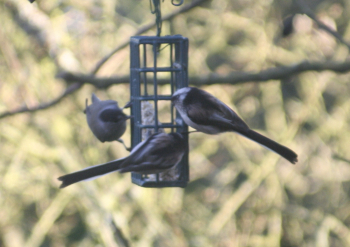 For the last few days we’ve had a blackcap visiting our garden. Here it is sharing the feeder with a couple from our troupe of long-tailed tits.
For the last few days we’ve had a blackcap visiting our garden. Here it is sharing the feeder with a couple from our troupe of long-tailed tits.
The Zebra is a wild member of the horse family that can be found throughout sub-Saharan Africa. There are three species of Zebra – the Common or Plains Zebra that is found all over Eastern and Southern Africa. The Mountain Zebra that is separated into two races, the Cape Mountain Zebra and the Hartmann’s Mountain Zebra. Finally the Grevy’s Zebra is the largest and rarest of Zebras and is found in northern Kenya and southern Ethiopia. Zebras are large animals and often overcome attacks from Lions. When being chased by Lions the stallion goes to the back of the herd and violently kicks out behind him. This method often deters Lions, as they cannot risk injury or even death. It is also believed that the Zebras stripes make it harder for Lions to see them, as Lions are partially colour-blind.
Common or Plains Zebra
The most common of the Zebra family that has the widest range of the three species. It is split into three different races that are shown below.
Grant’s Zebra: southern Sudan, Kenya, Tanzania, Zambia and northern Zimbabwe.
Chapman’s Zebra: Namibia, Angola and western South Africa.
Burchell’s Zebra: South Africa, Botswana, Swaziland, Zimbabwe and Mozambique.
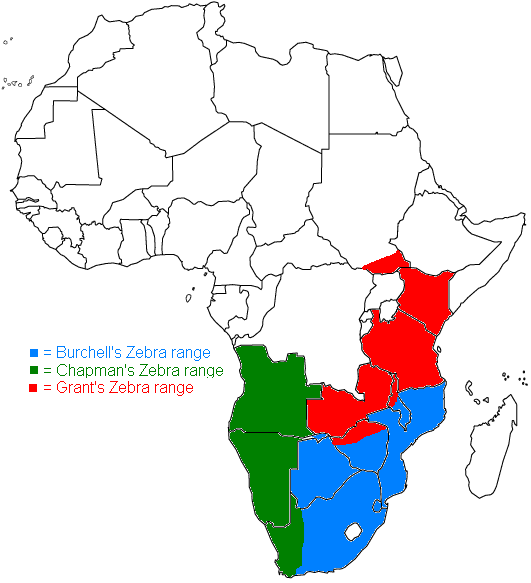
The Common Zebra is very common throughout southern and eastern Africa and often forms mixed herds with Wildebeest. It lives in herds of up to 100, although normally these herds would number 15-20. It is a grazing animal and prefers open plains but can be found in bush thickets, woodland, wetland and semi-desert.
Mountain Zebra
The Mountain Zebra has a smaller range than the Common Zebra and is harder to find in its upland habitat. Although they are named Mountain Zebras they are not really found on mountains, their preferred habitat is high-altitude plains and hills. There are two sub-species of Mountain Zebra, the Hartmann’s Mountain Zebra and the Cape Mountain Zebra.
Cape Mountain Zebra: western South Africa, Cape Province, northern Namibia.
Hartmann’s Mountain Zebra: southern Angola, Botswana, Zimbabwe, Northern South Africa, Swaziland and southern Mozambique.
Both sub-species are endangered although we were lucky enough to see them both on our holiday to South Africa in October 2004.
Grevy’s Zebra
Grevy’s Zebra are the largest and rarest of the three Zebra species. They have been over-hunted and persecuted for many years in east Africa. There are now as little as 3,000 remaining in the wild. They are a desert animal and are found in the scrub and aridlands of northern Kenya and southern Ethiopia. They used to be common in Somalia but became extinct there in 1973.
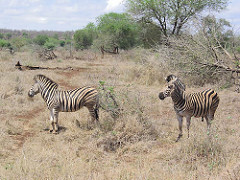

On Friday afternoon me, mum and clara came home to a rather unusual surprise. Rio (one of our two cats) had brought us a present, one we wouldn’t normally expect. Dad was at home and took the creature off Rio (that was still alive) and put it in a shoebox with some earth, water and a slug.
Both our cats kill, or attempt to kill lots of animals. Rio kills by far the most though. He brings home pretty much anything including mice, rats, squirrels and various birds including collared doves, woodpigeons, blackbirds and robins. He has also tried a hedgehog but failed. Sheeba tends to attack the smaller animals, all she’s ever killed is a spider although she often tries frogs and stag beetles! But this time Rio brought home a …………. Slow worm!
We had a look at it for a while before releasing it back into the garden, with the cats safely inside.
The black or hook lipped rhino is the smaller, more aggressive and rarer of the two species of African rhino, the black rhino and the white rhino. Black rhino are a critically endangered species and there are between 2,500 and 3,000 left in the wild. In the 1970s when poaching was most popular black rhinos were hunted to the very brink of extinction but now with armed patrols in many game reserves rhinos are making a steady recovery. Black rhinos breed well in captivity and being herbivores are easy to release into the wild. Unlike white rhino that live in small family groups of 3-4 the black rhino prefers to live a solitary life. Black rhinos are browsers and often use their 1.5 tonnes of weight to knock fruit down from trees. If black rhinos feel threatened by humans on foot they can charge at speeds of 30mph despite their massive weight. Black rhinos share the same habits of many other savannah animals like wallowing in mud and carrying oxpecker birds on their back to remove fleas and ticks. Rhinos drink once a day and sometimes use their horns and back legs to dig for water underground if water is scarce above the ground.
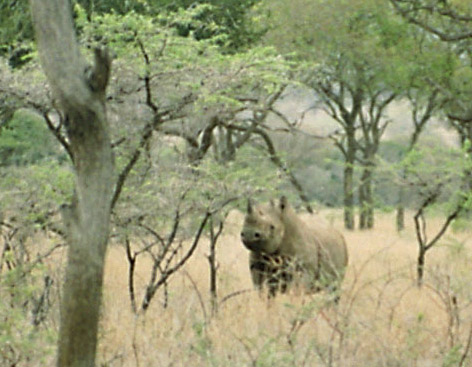
Black Rhino that mum and dad saw on their game walk in Mkuzi.
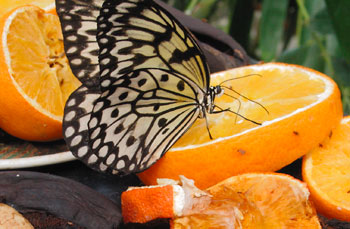 I’m working my way back through unpublished photos — highlights from our trips to the Longleat estate and Centerparcs are now in the photo library.
I’m working my way back through unpublished photos — highlights from our trips to the Longleat estate and Centerparcs are now in the photo library.
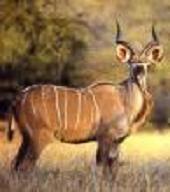 |
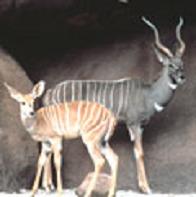 |
| Greater Kudu | Lesser Kudu |
There are two different types of Kudu, the Greater Kudu and the Lesser Kudu. The Greater Kudu is bigger than the lesser Kudu and have hair along their back and down the font of their throat. Another difference is that female Lesser Kudu are orange whilst Greater females are the same greyish colour as the males. Like most antelope the males have horns but the females don’t. Kudu are found in thick bush or forest where they can camouflage from Lions. They are more common in Southern Africa than East Africa because Southern Africa is bushier than East Africa. Small populations can also be found in the Kalahari Desert. Kudu live in family groups or small herds consisting of two or three families. As Greater Kudu are bigger then Lesser Kudu they have fewer predators. Lions and Crocodiles are the only natural predators of Greaters but Leopards may also hunt Lessers, particularly the females because they are smaller and easier to catch. Kudu have very good reactions and senses meaning they normally survive when Lions go after them. Poachers hunt Kudu for their horns, and the head, like many antelopes, is considered a valuable trophy. Because of this Kudu are classified as Lower Risk in their Conservation status.
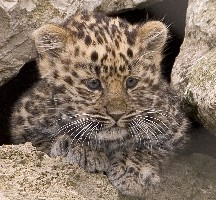 We were thrilled to see Amirah the Amur Leopard cub at Marwell zoo on the 26th March. Tom sent me this photograph of her. Two days later she was dead, killed by her father after squeezing through the rock barrier between their pens.
We were thrilled to see Amirah the Amur Leopard cub at Marwell zoo on the 26th March. Tom sent me this photograph of her. Two days later she was dead, killed by her father after squeezing through the rock barrier between their pens.
I hope Marwell are doing some hard thinking. In a rather Orwellian way, all mention of Amirah has vanished from their site. But she did exist, and Mike McCombie’s lovely set of photos, taken on the same day we visited, remains as a tribute.
The same week saw the deaths of Terri Schiavo, who spent fifteen years in a persistent vegetative state, and Pope John Paul II, who wanted her to remain in it.
|
Olive Baboon |
Chacma Baboon |
|
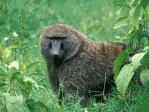
|
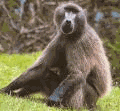
|
|
|
Animal Type |
Mammal – Primate |
Mammal – Primate |
|
Conservation Status |
Lower Risk |
Lower Risk |
|
Distribution |
Eastern Africa |
Southern Africa |
|
Habitat |
Savannah Scrub |
Savannah and City |
|
Predators |
Leopard, Lion, Cheetah and Crocodile |
Leopard, Lion, Cheetah and Crocodile |
|
Diet |
Fruit, Eggs, Fish, Monkeys and newborn antelope |
Fruit, Eggs, Fish, Monkeys and newborn antelope |
Baboons are social animals and live in large groups called troops. They are often seen with Impala because Baboon and Impala help each other keep safe by teaming up their senses. Despite this alliance Baboons will attempt to catch newborn Impala. Chacma Baboons are very tame. They are pests at the campsites in the wild and at the resorts and attractions in the city. Baboons will steal food from tourists. Baboons spend most of the day on the ground searching for food and playing with other members of the troop. In the night Baboons will go to their sleeping spot in the trees. Baboons have several sleeping spots around there territory and will sleep in the safest one. Chacma Baboons live for about 45 years whilst Olive Baboons live 30 ‘ 45 years.